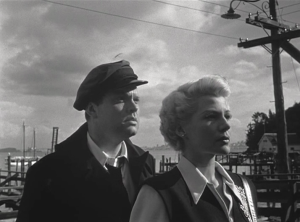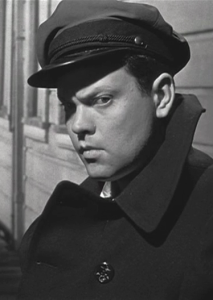 Welles Week: Part Five of Five
Welles Week: Part Five of Five
The Lady from Shanghai | Orson Welles | USA | 1948 | 87 min
UW Cinematheque, 4070 Vilas Hall, Saturday, February 14, 7:00 pm»
The Lady from Shanghai tells the story of a poor Irishman who first is the hero and then becomes the dupe of an elaborate scheme involving the woman he saved. Welles stars as the puppet, portraying a character that knowingly steps into a troubled group of people, and Rita Hayworth as the femme fatale convinces both the characters and the audience that she has nothing to hide until the last minutes of the film.
We conclude our week devoted to Orson Welles with Taylor Hanley’s review of The Lady From Shanghai (1948). The UW Cinematheque’s year-long series, Orson Welles: A Centennial Celebration begins with Citizen Kane on Saturday, January 24 at 7:00 pm.
From the beginning it is clear that there is something off about Michael O’Hare’s (Orson Welles) situation. His narration in the first minutes of the movie explicitly states that he will be drawn to a woman and this lust will ultimately lead him to trouble. We know that he will be the fool, but we don’t know how the trouble will manifest and who will cause it. The limited amount of knowledge of a looming problem creates suspense, but the extent of withheld information makes every character seem suspicious.
This suspense sustains viewer attention through the first half of the movie where there is merely melodramatic action and small bits of information to hold onto. Elsa (Rita Hayworth), the wife of the powerful lawyer Arthur Banister (Everett Sloane), is fond of Michael. From what we can tell, Michael feels similarly about Elsa. It is obvious that Arthur and his partner, George Grisby (Glenn Anders) are hiding something and their instability makes them ticking time-bombs.
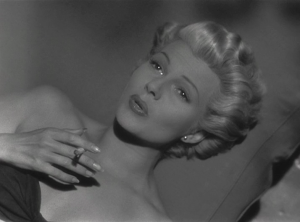 The little amount of information that is exposed to the audience during the first half of the film makes it hard to tell what is going on, who should be trusted and how this “trouble” might play out. The first half of the film was a guessing game for me, and in some ways I liked the way it kept me on my toes. After a while, though, guessing started to frustrate the hell out of me. I wondered if anything was actually going to manifest, or if the whole film was going to be a continuous stream of smooth talk between characters, like an inside joke that the audience is never let in on.
The little amount of information that is exposed to the audience during the first half of the film makes it hard to tell what is going on, who should be trusted and how this “trouble” might play out. The first half of the film was a guessing game for me, and in some ways I liked the way it kept me on my toes. After a while, though, guessing started to frustrate the hell out of me. I wondered if anything was actually going to manifest, or if the whole film was going to be a continuous stream of smooth talk between characters, like an inside joke that the audience is never let in on.
After stringing the audience along for so long, the film finally hooks its viewers when new information brings Michael and the audience into the the drama. This is when the story starts to speed up, and from this point on the film becomes increasingly more and more exciting. Grisby approaches Michael with a proposition of murder, and at this point Michael becomes the fool of an elaborate plan. There is a murder, and the blame goes to Michael. Michael wonders whether the world has gone insane or if he has.
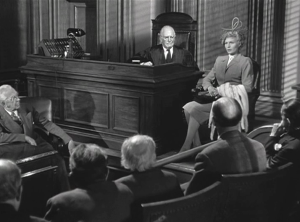 A courtroom scene seems to answer this question. The courtroom is wild, hysteric and constantly breaking out into fits of laughter, almost making me wish I had been chosen for jury duty. The judge cracks jokes, the jury talks out of turn, the lawyers yell spontaneously, and Arthur Banister performs a bit when he is asked to question himself that immediately made me think of Woody Allen in Bananas. The whole courtroom is unruly and unprofessional, as if the whole world had gone mad except Michael O’Hare.
A courtroom scene seems to answer this question. The courtroom is wild, hysteric and constantly breaking out into fits of laughter, almost making me wish I had been chosen for jury duty. The judge cracks jokes, the jury talks out of turn, the lawyers yell spontaneously, and Arthur Banister performs a bit when he is asked to question himself that immediately made me think of Woody Allen in Bananas. The whole courtroom is unruly and unprofessional, as if the whole world had gone mad except Michael O’Hare.
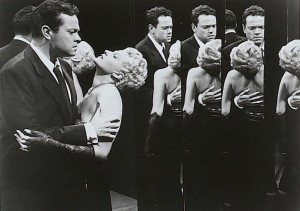 The style in The Lady from Shanghai is similar to other Welles films: long takes with camera movement to track character action, deep focus cinematography, strong contrasts of light and dark, and an extensive use of shadows. The style not only provides striking compositions but also adds intensity to the story. For instance, in one of the last scenes of the film Michael and two other characters find themselves in a Fun House—the coolest fun house I have ever seen—in the room of mirrors. The characters start shooting at each other, and quickly it becomes clear how to know if a character has been shot: if a shot is fired and glass breaks, then the shooter has mistaken the mirror for the character. But with the quick editing, jump-cuts and changes in shot scale, the accelerated pace of the scene ends the film in exhilarated excitement and the question, who will come out of this fun house alive?
The style in The Lady from Shanghai is similar to other Welles films: long takes with camera movement to track character action, deep focus cinematography, strong contrasts of light and dark, and an extensive use of shadows. The style not only provides striking compositions but also adds intensity to the story. For instance, in one of the last scenes of the film Michael and two other characters find themselves in a Fun House—the coolest fun house I have ever seen—in the room of mirrors. The characters start shooting at each other, and quickly it becomes clear how to know if a character has been shot: if a shot is fired and glass breaks, then the shooter has mistaken the mirror for the character. But with the quick editing, jump-cuts and changes in shot scale, the accelerated pace of the scene ends the film in exhilarated excitement and the question, who will come out of this fun house alive?
Though the lack of story in the first half of the film frustrated me, my attention was still sustained by the suspense that was established and the actor’s performances. I enjoyed the goof-ball, oddities of Grisby; Glen Ander’s performance gave the first half of the film much needed flavor. He turned simple lines into quirky expressions, and his shifty and sweaty persona heightened the suspense. However, once it picked up pace, the film turned into something I couldn’t look away from. The final scenes of The Lady from Shanghai contrast with the first half’s simplicity, as the story becomes much more complex and the style much more vivid and exhilarating.
